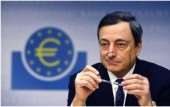 For seekers of alpha, recent headline news seems bearish for the euro and bullish on the U.S. dollar. The Federal Reserve is going to allow interest rates to rise, while the ECB is resolutely going to resist that fate. Yet it is all so obvious, and seems all so played-out-already (Aaron Smith of Pecora Capital was saying exactly this about each currency back in June) that on a second thought one has to worry.
For seekers of alpha, recent headline news seems bearish for the euro and bullish on the U.S. dollar. The Federal Reserve is going to allow interest rates to rise, while the ECB is resolutely going to resist that fate. Yet it is all so obvious, and seems all so played-out-already (Aaron Smith of Pecora Capital was saying exactly this about each currency back in June) that on a second thought one has to worry.
One of the ”behavioral” realities at work may be that central bankers stand up for one another, as members of a common guild, even when they’re heading in opposite directions. So maybe, the directions really aren’t ‘opposite.’
With that in mind, let’s get to the headlines. Mario Draghi, President of the ECB, hosted a press conference on November 6th. It has drawn a good deal of commentary.
The bullet point view of this press conference runs thus:
1) The governing council of the ECB has decided to keep the key interest rates unchanged. This means that the main financing rate will stay at its record low of 0.05%.
2) More important, the type of asset that the ECB purchases in order to create money is changing. “[W]e last month purchasing covered bonds under our new programme. We will also soon start to purchase asset-backed securities.”
3) Separately, and perhaps still more important, the ECB will engage in a “series of targeted longer-term refinancing operations to be conducted until June 2016.”
The following day Christopher Noyer, a member of that governing council and the Governor of the Bank of France, at a symposium sponsored by that national bank, made a statement that sounded a bit like the rumblings of dissent in regard to Draghi’s let’s-print-even-more-money policy. Noyer said that policy makers have been relying too heavily on central banks, treating them like “the only game in town,” and forgetting that “central bankers do not act in a vacuum.”
That was diplomatically put. Draghi hadn’t said that the ECB does or can operate “in a vacuum,” so Noyer wasn’t posing any direct opposition. But he may have been signaling that Draghi was uncomfortably comfortable with being the only game.
Rebellion Appears and Disappears
Let’s back up a bit. On November 4th, election day in the U.S., Reuters ran a story, written by Eva and Paul Taylor, declaring that Draghi faced a rebellion within his ranks. An anonymous insider had apparently told Reuters that Draghi was creating “exactly the expectations we [want] to avoid” a “rod for our own backs.” That’s exactly what he was doing on the 6th, so one might have expected some push-back from whoever these anonymous rebels were.
On the 7th, later on the day of Noyer’s mutedly-rebellious comments, Janet Yellen spoke up, at the same symposium that Noyer had opened. She said, “We central bankers have saved the world.” Uh, not exactly. She put it this way, “With policy rates at or approaching zero, central banks of necessity turned to unconventional policy tools such as large-scale asset purchases and enhanced forward guidance about the future path of policy rates. These unconventional tools have, in my view, served to support a recovery in domestic demand and, as a consequence, global economic growth.”
But at the moment, the ECB and the FRB seem headed in opposite directions. The Federal Reserve is tapering its own asset purchases, and the ECB, Draghi tells us, is resolutely disinclined to taper at all. Can they both be right? Well … yes, Yellen says.
Get Into Realities
She went out of her way to give Draghi a put on the back here. “At the European Central Bank… the recent comprehensive assessment is an important step toward building confidence in euro-area banks. I wish the ECB great success….”
What lies beneath? Perhaps the notion that the Federal Reserve can no longer serve as the world’s bazooka. It has to rest, long enough to reload if nothing else, and since the Bernanke/Yellen view about what ought to be done hasn’t changed, another bazooka has to fill the void. Yellen and Draghi are, in other words, working in shifts, weakening both currencies. By definition they can’t weaken both currencies against each other, but they certainly can weaken both against the various goods and services currencies are used to purchase.
So perhaps the best play isn’t to buy one currency and sell another, nor to borrow in one and lend in the other. Perhaps the best play right now is … get out of currencies and into realities.



